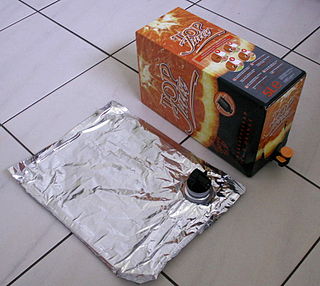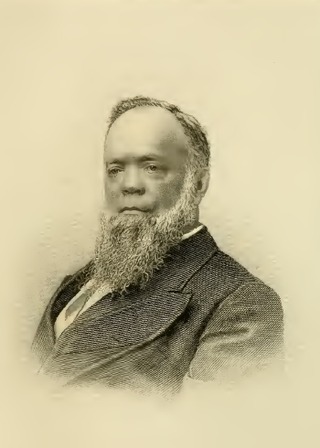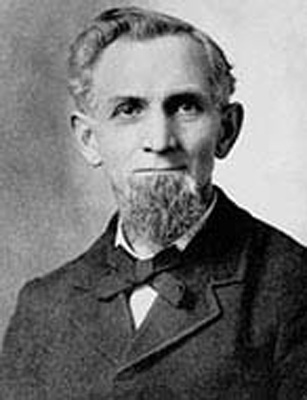Related Research Articles

A tea bag, or the compound teabag, is a small, porous, sealed bag or packet, typically containing tea leaves or the leaves of other herbs, which is immersed in water to steep and make an infusion. Originally used only for tea, they are now made with other tisanes as well.

A zipper, zip, fly, or zip fastener, formerly known as a clasp locker, is a commonly used device for binding together two edges of fabric or other flexible material. Used in clothing, luggage and other bags, camping gear, and many other items, zippers come in a wide range of sizes, shapes, and colors. In 1892, Whitcomb L. Judson, an American inventor from Chicago, patented the original design from which the modern device evolved.

Margaret Eloise Knight was an American inventor, notably of a machine to produce flat-bottomed paper bags. She has been called "the most famous 19th-century woman inventor". She founded the Eastern Paper Bag Company in 1870, creating paper bags for groceries similar in form to the ones that would be used in later generations. Knight received dozens of patents in different fields, and became a symbol for women's empowerment.

A bag-in-box or BiB is a container for the storage and transportation of liquids. It consists of a strong bladder, usually made of several layers of metallised film or other plastics, seated inside a corrugated fiberboard box.

Ziploc is a brand of reusable, re-sealable sliding channel storage bags and containers originally developed and test marketed by The Dow Chemical Company in 1968 and now produced by S. C. Johnson & Son.

Plastic shopping bags, carrier bags, or plastic grocery bags are a type of plastic bag used as shopping bags and made from various kinds of plastic. In use by consumers worldwide since the 1960s, these bags are sometimes called single-use bags, referring to carrying items from a store to a home. However, it is rare for bags to be worn out after single use and in the past some retailers incentivised customers to reuse 'single use' bags by offering loyalty points to those doing so. Even after they are no longer used for shopping, reuse for storage or trash is common, and modern plastic shopping bags are increasingly recyclable or compostable. In recent decades, numerous countries have introduced legislation restricting the provision of plastic bags, in a bid to reduce littering and plastic pollution.

Whitcomb L. Judson was an American machine salesman, mechanical engineer and inventor. He received thirty patents over a sixteen-year career, fourteen of which were on pneumatic street railway innovations. Six of his patents had to do with a motor mechanism suspended beneath the rail-car that functioned with compressed air. He founded the Judson Pneumatic Street Railway.

A paper bag is a bag made of paper, usually kraft paper. Paper bags can be made either with virgin or recycled fibres to meet customers’ demands. Paper bags are commonly used as shopping carrier bags and for packaging of some consumer goods. They carry a wide range of products from groceries, glass bottles, clothing, books, toiletries, electronics and various other goods and can also function as means of transport in day-to-day activities.

Bag tags, also known as baggage tags, baggage checks or luggage tickets, have traditionally been used by bus, train, and airline carriers to route checked luggage to its final destination. The passenger stub is typically handed to the passenger or attached to the ticket envelope:
- to aid the passenger in identifying their bag among similar bags at the destination baggage carousel;
- as proof—still requested at a few airports—that the passenger is not removing someone else's bag from the baggage reclaim hall; and
- as a means for the passenger and carrier to identify and trace a specific bag that has gone astray and was not delivered at the destination. The carriers' liability is restricted to published tariffs and international agreements.

Walter Hunt was an American mechanical engineer. Through the course of his work he became known for being a prolific inventor. He got first involved with mechanical innovations in a linseed producing community in New York state that had flax mills. While in New York City to promote his inventions he got involved in inventing the streetcar gong that was used throughout the United States. This then led him to invent other useful items like the safety pin and sewing machine. He invented the precursor to the repeating rifle and fountain pen. About two dozen of his inventions are used today in basically the same form as he had patented them. In spite of his many useful innovative creations he never became wealthy since he sold off most of his patent rights to others at low prices with no future royalties. Others made millions of dollars from his safety pin device.

Charles Frances Ritchel was an American inventor of a successful dirigible design, the fun house mirror, a mechanical toy bank, and the holder of more than 150 other patented inventions.

Cornhole is a lawn game popular in North America in which players or teams take turns throwing fabric bean bags at a raised, angled board with a hole in its far end. The goal of the game is to score points by either landing a bag on the board or putting a bag through the hole.

George West was an industrialist and a U.S. Representative from New York.

James Murray Spangler was an American inventor, salesman, and janitor who invented the first commercially successful portable electric vacuum cleaner that revolutionized household carpet cleaning. His device was not the first vacuum cleaner, but it was the first that was practical for home use. It was the first to use both a cloth filter bag and cleaning attachments. Spangler improved this basic model and received a patent for it in 1908. He formed the Electric Suction Sweeper Company to manufacture his device. William H. Hoover was so impressed with the vacuum cleaner that he bought into Spangler's business and patents.
Walter H. Deubener (1887–1980) was a grocer from St. Paul, Minnesota who in 1912 invented the handled paper grocery bag. Following his death, his estate became Camp Courage North. The annual Deubener Award, given out to small businesses by the St. Paul Area Chamber of Commerce, is named after him.

A timeline of United States inventions (1890–1945) encompasses the ingenuity and innovative advancements of the United States within a historical context, dating from the Progressive Era to the end of World War II, which have been achieved by inventors who are either native-born or naturalized citizens of the United States. Copyright protection secures a person's right to his or her first-to-invent claim of the original invention in question, highlighted in Article I, Section 8, Clause 8 of the United States Constitution which gives the following enumerated power to the United States Congress:
To promote the Progress of Science and useful Arts, by securing for limited Times to Authors and Inventors the exclusive Right to their respective Writings and Discoveries.
Francis Wolle was an American priest of the Moravian Church, inventor and phycologist.
Charles Shor is an American businessman and philanthropist from Cincinnati, Ohio. He served as the President and chief executive officer of the world's largest paper bag manufacturing company, Duro Bag Manufacturing from 1987 to 2014 before selling it to South Carolina-based Hilex Poly Co. LLC.
Charles B. Brooks (1865–1956) was an American inventor. Born in Virginia in 1865, by the 1890s he was a resident of Newark, New Jersey. Besides inventing, Brooks was a porter for the Pullman Palace Car Company. Unlike other sweepers at that time (1890s), Brooks’ sweeper was the first self-propelled street sweeping truck. His design had revolving brushes attached to the front fender, and the brushes were interchangeable so that when snow fell, scrapers could be attached for snow removal. He received a patent for his invention on March 17, 1896. A few months later, on May 12, 1896, he patented a dust-proof collection bag for the street sweeper.
William B. Purvis was an African-American inventor and businessman who received multiple patents in the late 1800s. His inventions included improvements on paper bags, an updated fountain pen design, improvement to the hand stamp, and a close-conduit electric railway system.
References
- ↑ "Charles Stilwell". Ohio History Central . Retrieved December 16, 2012.